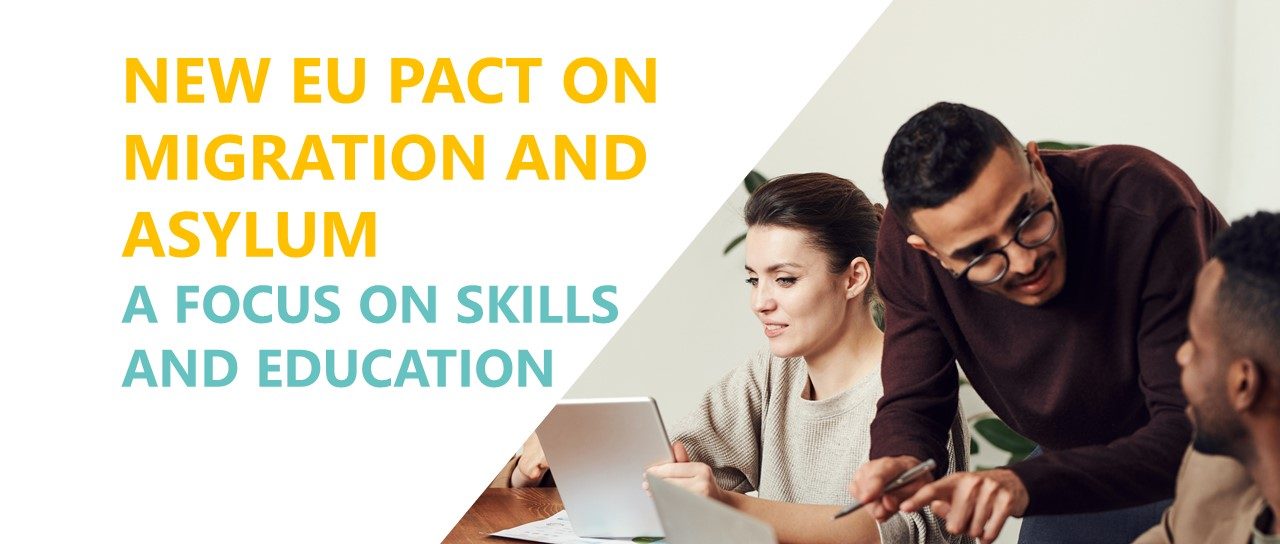This article is written by Paul Hammoud, Communications Manager at Diesis Network.
Being written in the framework of the ICT4TCN project, this article will mainly present the skills and education references of the Pact that aim to integrate migrants in the EU societies and labour market. Moreover, it also enters as an additional perspective to the many projects related to migration and education Diesis Network has worked on, and is still working on, such as EMEN, MAX, NT4EU and Zelda.
On 23 September 2020, the European Commission introduced the New Pact on Migration and Asylum for the management of migration and asylum in Europe. It has been launched under the fifth priority of the Commission’s ‘Promoting our European Way of Life’ programme. The New Pact acknowledges that internal and external aspects of migration are interdependent and aims for a more effective, sustainable, and more humane migration and asylum system. The key aspects defined are a safer entering, a better integration and a better distribution of migrants and refugees in the EU Member States. It “tries to integrate the interlinkages between different migration policy areas and between the internal, external and border control dimensions more thoroughly than in the past.” [1]
With this Pact, the Commission proposes a new balance between responsibility and solidarity to build (a new) confidence with its Members States and citizens. To do so, several facets are presented, such as well-managed Schengen and external borders, an effective solidarity, and a stronger trust fostered by better and more effective procedures. Another key facet to build this confidence lies with the skills and education of third country nationals, for which we have a particular interest in this article.
SKILLS AND TALENT PACKAGE
Looking at the Impact of Demographic Change in Europe report, Europe’s Member States have lower birth rates, ageing and shrinking population and skills shortages that need to be addressed. Moreover, other OECD countries, such as the USA, Canada, and Australia, are attracting more talent from abroad. The New Pact will promote legal migration to the EU through a new Skills and Talent Package to be proposed in 2021 that will include a number of legislative changes:
- Finalise reform of the EU Blue Card Directive to attract the highly skilled talent needed in different labour markets.
- Revise the Long-term Residence Directive to strengthen the rights of residents to move and work in different Member States.
- Revise the Single Permit Directive to simplify the procedures for low and medium skilled workers.
- Set up an EU Talent Pool to match skilled workers wishing to move to the EU with the needs of EU employers.
These actions are targeting specific migrant profiles to attract the talent the EU needs, from low to highly skilled workers.
The Pact also proposes to offer legal pathways to help make Europe an open, globally connected continent and to reduce irregular migration and its human and economic costs. Moreover, migrants arriving and living in the EU face several challenges of employment, lack of educational or training opportunities, and limited social interaction. In addition, a public consultation [2] was launched in September to attract skills and talent to the EU, to invite stakeholders to propose new ideas to boost the EU’s attractiveness, facilitate skills matching and better protect labour migrants from exploitation. The responses will feed into the Skills and Talent package. It is open until 30 December 2020.
EDUCATION FOR THIRD COUNTRY NATIONALS
The pandemic revealed just how many, “essential functions” across the continent are performed by “key workers” who are often migrants.[3] A Joint Research Centre (JRC) analysis highlights the critical contribution of migrant workers to the ongoing effort to keep basic services running in the European Union during the coronavirus pandemic. “On average, 13% of all key workers are immigrants in the EU.”[4] It is then necessary to successfully integrate them. In the Pact, the Commission recalls that a successful integration benefits newcomers and local communities and sets a positive example for how Europe can manage migration by building open and resilient societies.
To achieve the objective of successful integration, an Action Plan on integration and inclusion (for 2021-2024) will draw on all relevant policies and tools in key areas such as education, employment, and social inclusion. The recently renewed European Partnership for Integration (through work), established with Economic and Social Partners, is also present in the new Pact. A dedicated expert group will also include the views of migrants in the development of policies, including education and job creation. These measures provide incentives and support for Member States, which primarily have the responsibility for integration, and other actors in their efforts to promote integration.[5]
On the relations with non-EU countries, “the focus will be on key partner countries of origin and transit, based on an analysis of EU and partners’ interests.” The mutual support between the EU Commission and the partner countries is to ensure the measures and actions will be implemented and delivered, in key fields such as the economy, education and skills, and relations with diasporas. The EU and its Member States will work on developing policy and financing tools in areas such as employment, visa policy, education and research, including through more strategic, policy-driven programming of the EU’s external funding.[6]
[1] Michael Spindelegger (Director of the International Centre for Migration Policy Development (ICMPD), Understanding the new pact on Migration and Asylum as an opportunity, 2 October 2020, https://www.euractiv.com/section/justice-home-affairs/opinion/understanding-the-new-pact-on-migration-and-asylum-as-an-opportunity/
[2] European Commission, Public consultation on the future of EU legal migration, https://ec.europa.eu/info/law/better-regulation/have-your-say/initiatives/12594-Public-consultation-on-legal-migration
[3] Shada Islam, Europe’s migration ‘crisis’ isn’t about numbers. It’s about prejudice, 8 October 2020, https://www.theguardian.com/world/2020/oct/08/europe-migration-crisis-prejudice-eu-refugee-orban-christian
[4] J.R.C. European Commission, Immigrant Key Workers: Their Contribution to Europe’s COVID-19 Response, 23 April 2020, https://ec.europa.eu/knowledge4policy/sites/know4pol/files/key_workers_covid_0423.pdf
[5] European Commission, New Pact on Migration and Asylum: Questions and Answers, 23 September 2020, https://ec.europa.eu/commission/presscorner/detail/en/qanda_20_1707#contains
[6] European Commission, New Pact on Migration and Asylum: Questions and Answers, 23 September 2020, https://ec.europa.eu/commission/presscorner/detail/en/qanda_20_1707#contains
